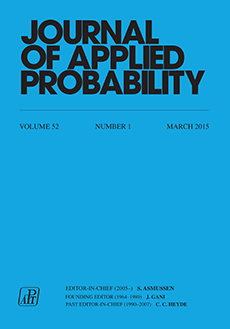Abstract
In a discrete-time single-type Galton--Watson branching random walk {Zn, ζn}n≤ 0, where Zn is the population of the nth generation and ζn is a collection of the positions on ℝ of the Zn individuals in the nth generation, let Yn be the position of a randomly chosen individual from the nth generation and Zn(x) be the number of points in ζn that are less than or equal to x for x∈ℝ. In this paper we show in the explosive case (i.e. m=E(Z1∣ Z0=1)=∞) when the offspring distribution is in the domain of attraction of a stable law of order α,0 <α<1, that the sequence of random functions {Zn(x)/Zn:−∞<x<∞} converges in the finite-dimensional sense to {δx:−∞<x<∞}, where δx≡ 1{N≤ x} and N is an N(0,1) random variable.
Citation
K. B. Athreya. Jyy-I Hong. "An application of the coalescence theory to branching random walks." J. Appl. Probab. 50 (3) 893 - 899, September 2013. https://doi.org/10.1239/jap/1378401245
Information





